
Donkey Kong Country is a 1994 platform game developed by Rare and published by Nintendo for the Super Nintendo Entertainment System (SNES). It is a reboot of Nintendo's Donkey Kong franchise and follows the gorilla Donkey Kong and his nephew Diddy Kong as they set out to recover their stolen banana hoard from the crocodile King K. Rool and his army, the Kremlings. The single-player traverses 40 side-scrolling levels as they jump between platforms and avoid obstacles. They collect items, ride minecarts and animals, defeat enemies and bosses, and find secret bonus stages. In multiplayer modes, two players work cooperatively or race each other.

Donkey Kong Land is a 1995 platform game developed by Rare and published by Nintendo for the Game Boy. It condenses the side-scrolling gameplay of the Super Nintendo Entertainment System (SNES) game Donkey Kong Country (1994) for the handheld Game Boy with different level design and boss fights. The player controls the gorilla Donkey Kong and his nephew Diddy Kong as they defeat enemies and collect items across 30 levels to recover their stolen banana hoard from the crocodile King K. Rool.

Donkey Kong 64 is a 1999 platform game developed by Rare and published by Nintendo for the Nintendo 64. It is the only Donkey Kong game to feature 3D gameplay. As the gorilla Donkey Kong, the player explores themed levels to collect items and rescue his kidnapped family members from King K. Rool. The player completes minigames and puzzles as five playable Kong characters—each with their own special abilities—to receive bananas and other collectibles. In multiplayer modes, up to four players can compete in deathmatch and last man standing games.
Ashby Computers and Graphics Limited, trading as Ultimate Play the Game, was a British video game developer and publisher, founded in 1982, by ex-arcade video game developers Tim and Chris Stamper. Ultimate released a series of successful games for the ZX Spectrum, Amstrad CPC, BBC Micro, MSX and Commodore 64 computers from 1983 until 1987. Ultimate are perhaps best remembered for the big-selling titles Jetpac and Sabre Wulf, each of which sold over 300,000 copies in 1983 and 1984 respectively, and their groundbreaking series of isometric arcade adventures using a technique termed Filmation. Knight Lore, the first of the Filmation games, has been retrospectively described in the press as "seminal ... revolutionary" (GamesTM), "one of the most successful and influential games of all time" (X360), and "probably ... the greatest single advance in the history of computer games" (Edge).

Radar Scope is a 1980 shoot 'em up arcade game developed by Nintendo R&D2 and published by Nintendo. The player assumes the role of the Sonic Spaceport starship and must wipe out formations of an enemy race known as the Gamma Raiders before they destroy the player's space station. Gameplay is similar to Space Invaders and Galaxian, but viewed from a three-dimensional third-person perspective.

Rare Limited is a British video game developer and a studio of Xbox Game Studios based in Twycross, Leicestershire. Rare's games span the platform, first-person shooter, action-adventure, fighting, and racing genres. Its most popular games include the Battletoads, Donkey Kong, and Banjo-Kazooie series, as well as games like GoldenEye 007 (1997), Perfect Dark (2000), Conker's Bad Fur Day (2001), Viva Piñata (2006), and Sea of Thieves (2018).

Masayuki Uemura was a Japanese engineer, video game producer, and professor. He was known for his work as an employee of Nintendo from 1971 to 2004, most notably for serving as a key factor in the development of the Nintendo Entertainment System.

Jetpac is a shooter video game developed and published by Ultimate Play the Game and released for the ZX Spectrum and VIC-20 in 1983 and the BBC Micro in 1984. It is the first game to be released by Ultimate Play the Game, the company which later became Rare. The game follows Jetman as he must rebuild his rocket in order to explore different planets, while simultaneously defending against hostile aliens. It was written by Ultimate co-founder Chris Stamper with graphics designed by his brother, Tim Stamper. Reviewers praised Jetpac's presentation and gameplay, and it won "Game of the Year" at the Golden Joystick Awards in 1983.

Knight Lore is a 1984 action-adventure game developed and published by Ultimate Play the Game, and written by company founders Chris and Tim Stamper. The game is known for its use of isometric graphics, which it further popularized in video games. In Knight Lore, the player character Sabreman has forty days to collect objects throughout a castle and brew a cure to his werewolf curse. Each castle room is depicted in monochrome on its own screen and consists of blocks to climb, obstacles to avoid, and puzzles to solve.
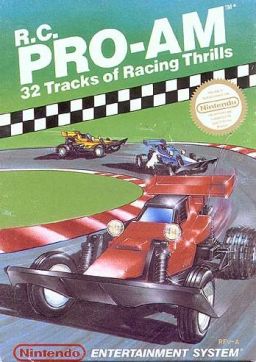
R.C. Pro-Am is a racing video game developed by Rare and published by Nintendo for the Nintendo Entertainment System. It was released in North America in February 1988, and then in Europe on April 15. Presented in an overhead isometric perspective, a single player races a radio-controlled car around a series of tracks in vehicular combat. Each track qualifies its top three racers for the next track. Collectible power-up items improve performance, hazards include rain puddles and oil slicks, and missiles and bombs can temporarily disable opponents. Originally titled Pro Am Racing, it was ported to the Sega Genesis in 1992 as Championship Pro-Am, an enhanced remake with enhanced graphics and additional features. R.C. Pro-Am spawned two sequels: Super R.C. Pro-Am in 1991, and R.C. Pro-Am II in 1992.

The Nintendo VS. System is an arcade system developed and produced by Nintendo from 1984 to 1990. It is based on most of the same hardware as the Family Computer (Famicom), later released as the Nintendo Entertainment System (NES). Most of its games are conversions from the Famicom and NES, some heavily altered for the arcade format, and some debuted on the VS. System before being released on the Famicom or NES. The system focuses on two-player cooperative play. It was released in three different configurations: upright VS. UniSystem cabinets, upright VS. DualSystem cabinets, and sit-down VS. DualSystem cabinets. Games are on pluggable circuit boards, allowing for each side to have a different game.
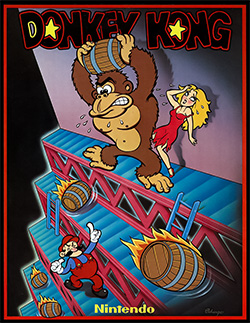
Donkey Kong is a 1981 arcade video game developed and published by Nintendo. As Jumpman, the player runs and jumps on platforms and climbs ladders to ascend a construction site and rescue Pauline from a giant gorilla named Donkey Kong. It is the first game in the Donkey Kong series as well as Mario's first appearance in a video game.

It's Mr. Pants is a puzzle video game developed by Rare. It was published by THQ for the Game Boy Advance (GBA) handheld game console in North America and Europe in 2004–2005. A port of the game for mobile phones was developed and published internationally by In-Fusio in 2005–2006. The game stars Mr. Pants, a crudely drawn mascot formerly featured on Rare's website who had made cameo appearances in several prior Rare games.
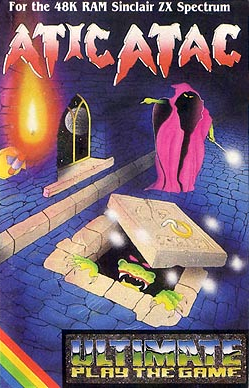
Atic Atac is an arcade-adventure video game developed and published by Ultimate Play the Game, released for the ZX Spectrum in 1983 and the BBC Micro in 1985. The game takes place within a castle in which the player must seek out the "Golden Key of ACG" by unlocking doors and avoiding enemies. It was Ultimate's second game to require 48K of RAM; most of their previous games for the Spectrum ran on unexpanded 16K models.

Cobra Triangle is a 1989 racing, vehicular combat video game developed by Rare and released by Nintendo for the Nintendo Entertainment System. The player controls a weapon-equipped speedboat through 25 levels. Objectives include winning races, saving swimmers, and defusing bombs. The game also includes power-ups and is displayed from a 3D isometric perspective with automatic scrolling that follows the player's movement. The Stamper brothers designed the game and David Wise wrote its soundtrack. Computer and Video Games highly recommended the game and praised its graphics and gameplay. Later reviewers lauded its level diversity and noted its graphical similarities to previous Rare game R.C. Pro-Am. IGN and GamesRadar ranked Cobra Triangle among their top NES games. The latter considered Cobra Triangle emblematic of the NES era's aesthetic. It was also included in Rare's 2015 Xbox One retrospective compilation, Rare Replay.
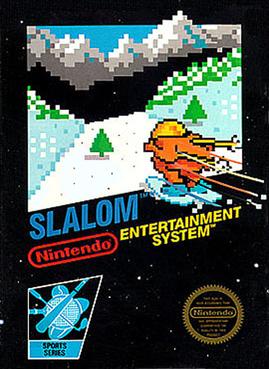
Slalom, originally released as VS. Slalom, is a skiing sports video game developed by Rare and published by Nintendo in 1986 for the Nintendo VS. System in arcades. It was then released for the Nintendo Entertainment System in North America in March 1987 and in Europe later that year. The player races in a series of downhill slalom skiing runs while navigating past flags and obstacles before time expires. It was developed by Tim and Chris Stamper and its music was composed by David Wise.
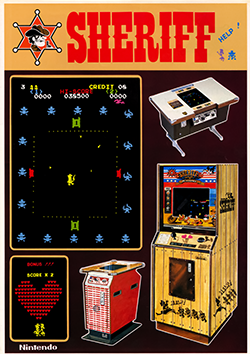
Sheriff, also known as Bandido, is a 1979 multi-directional shooter arcade game by Nintendo. It is one of several Western-themed video games from the 1970s, along with Western Gun, Outlaw, and Boot Hill. The player controls a county sheriff tasked with defense of a town against bandits, to rescue the captured woman. It was a commercial success in Japan, where it was among the top ten highest-grossing arcade games of 1979.
Donkey Kong is a video game franchise created by Shigeru Miyamoto and owned by Nintendo. It follows the adventures of a gorilla, named Donkey Kong, and his family and friends consisting of various primates. The franchise primarily consists of platform games—originally single-screen action puzzle games and later side-scrolling platformers. The first is the 1981 arcade game Donkey Kong, debuting the main antagonist Donkey Kong and the hero Mario, in an industrial construction setting. The game was a massive success and was followed by two sequels released in 1982 and 1983. In 1994, the franchise was relaunched with the platformer Donkey Kong Country, in which Donkey Kong is antagonized by a variety of anthropomorphic enemies, mainly the Kremlings, a clan of crocodiles led by King K. Rool, who has stolen the Kongs' banana hoard.

Project Dream was the codename of a role-playing video game (RPG), Dream: Land of Giants, that served as the basis for the 1998 game Banjo-Kazooie. Developed by Rare, it was aimed for release on the Super Nintendo Entertainment System (SNES), and later the Nintendo 64 (N64). The plot followed a young boy, Edson, who caused trouble with pirates. The SNES version of Dream used an isometric perspective and had a fairy tale theme. After transitioning to the N64, the project became a more complex 3D RPG that had a greater emphasis on the pirate theme. Eventually, Dream was scaled back to a linear platform game in the vein of Donkey Kong Country (1994) that starred Banjo the bear, who became the protagonist of Banjo-Kazooie.

















